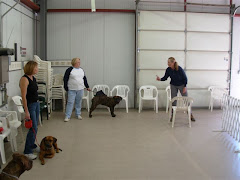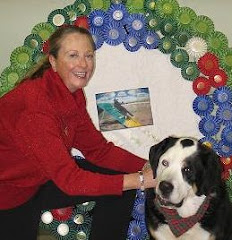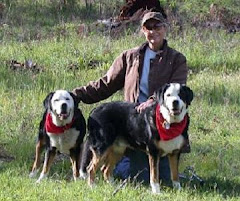Murphy and Lexi are best friends, but they sound like they're killing each other when they play. Murphy, a chocolate Lab, has known Lexi, a shepherd mix, for more than a year. They walk together, with their owners, every morning. They spend time at each other's houses. They've attended doggy school together.
But when they launch into a play session, it looks and sounds vicious--even to the trained eye. Their play is quite harmless. It's how they choose to have fun together. There's no need for parental intervention unless they start knocking over lamps and furniture. Maybe it gives you the willies to watch their teeth flashing and jaws gnashing at each other, but--really, mom--it's okay.
If you've ever observed a doggy daycare, you've seen how roughly dogs will play with each other. It may look like a fight to a casual observer, but it's actually a friendly interaction.
A true dog fight is much different. Fortunately they don't happen very often. When they do, they will leave all dogs and people involved shaken, physically and emotionally.
A dog fight is a horrible thing to witness. The sweetest, gentlest dog you've ever met turns into a temporarily vicious, wild and uncontrollable animal. They become seemingly blinded with a rage to subdue their opponent and survive. During the process, one or both dogs will probably sustain injuries. Puncture wounds are most frequent in a serious fight. Even if no blood is spilled, both dogs will usually experience soreness and stiffness the next day, because the struggle itself take such a toll on their muscles.
The worst thing about a dog fight, from the human observer's standpoint, is the sense of helplessness as you attempt to break it up. Whether the dogs are malamutes or Yorkies, two fighting dogs become a seething mass of fur in perpetual motion. All muscles are tensed and straining. Chances are, you won't even be able to grab a dog's collar because the dogs will be moving so fast and violently. If you do grab a collar, you'll probably pick up both dogs at the same time because they'll be so engaged with each other...and you may get bitten in the process, although you're only collateral damage. Dogs literally lose their minds during these fighting moments. They hear nothing and feel nothing except an adrenaline rush.
What sparks such violent reactions between two otherwise docile pets? Usually there's already an underlying tension between the two animals, and a trigger sets it off. The trigger could be a scrap of food, a prized possession (like a human being) or even a nasty look. Why do some dogs not like each other to begin with? The same reasons some humans don't hit it off...two strong personalities clashing for leadership, two females vying for affection of the same male (dog or human), or maybe they just don't like each other's looks. Two females with "issues," be it dominance, fear aggression, or jealousy, are a volatile combination. Two unneutered males are also a dangerous mix. While there are exceptions to every rule, most breeders of high-drive dogs will advise buyers not to have two females or two males of the same breed living together.
I've seen dogs absolutely freak when first see certain types of dogs. Back at Manning Dog Training, dogs used to go berserk when an Afghan would enter the classroom. Same reaction with a clipped standard poodle or an Irish wolfhound. They looked different, and the other dogs didn't trust them. Their reaction is to offer up a strong offense. My own dog has a distrust of fuzzy white dogs, probably because she was attacked by one a few years ago.
Offense or Defense: Which position does your dog usually play?
An "offensive" fighter is one who is looking for a confrontation. He enters onto the scene with a chip on his shoulder, visible in a stiff-legged strut that makes him as large as possible. His hair may be up, as will his tail. He looks like a bully. His brow may be furrowed; his ears will be forward and alert. He may display teeth and utter a very audible growl.A "defensive" fighter will wait for the offense to approach him. His stance--tail to neck--will be lower. He will tense. He will avoid direct eye contact with the offense, but will be acutely aware of his moves. He is saying, "I really don't want to fight you, but I will if I have to defend myself."
Photo: The Cocker is the "offense" and approaches the Min Pin with curiosity. The Min Pin thinks he's too "forward" and shows a defensive aggressive posture. Here, the Min Pin will be the first to strike, and this could bring on a nasty scuffle.
This is the moment to diffuse the fight! When you see these types of extreme, wary body language, get your dog's attention back on you before he growls and strikes out toward the other dog. Once they engage, you may be too late. Breaking up a dog fight can seem impossible once it starts.
To break up a fight, use whatever means are available. Throw a chair at the dogs if you need to. You will probably do less bodily harm to them this way than by letting them maim each other. The best technique is to spray them with a garden hose if you're lucky enough to have one sitting there, already on, right next to the dog fight. Throwing a towel or jacket over and between the dogs may also work, because it will break the action just long enough that you might get them apart. If you have pepper spray, consider using it. A few minutes of coughing and wheezing is better than puncture wounds and lacerations.
Even if your dog generally plays well with others, know his tolerances. Rough play may start out innocently enough, but escalate into a serious scuffle if one dog starts feeling overwhelmed by another. Yipping and squealing can often set off a negative reaction from the aggressor, whose prey drive may kick in and arouse him to cross the line. If your dog is feeling tired or grouchy from activity the day before, know that he'll be more defensive and less good-natured in his play.
The bottom line: know your dog and be realistic about his social shortcomings. Protect him from social interactions that could escalate to injury. Let your dog play in a way that is appropriate for your dog, and with friends who are appropriate for him or her. It doesn't sound much different from raising kids, does it?





















No comments:
Post a Comment